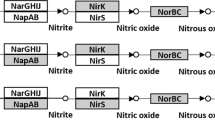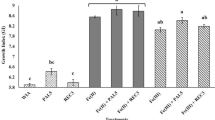Summary
Spring-wheat plant seedlings were inoculated with various isolates of nitrogen-fixing rhizosphere bacteria, includingAzospirillum brasilense, in gnotobiotic sand cultures. Bacteria which had lost their acetylene reduction activity (ARA) during purification did not regain it in the presence of the plant. Bacteria with stable ARA were stimulated to low ARA (maximum 5.6 nmol C2H4 plant−1 h−1) by young (22–32-day) wheat seedlings.
Similar content being viewed by others
References
Avivi Y and Feldman M 1982 The response of wheat to bacteria of the genus Azospirillum. Israel J. Bot. 31, 237–245.
Baldani V L D and Döbereiner J 1980 Host-plant specificity in the infection of cereals withAzospirillum spp. Soil Biol. Biochem. 12, 433–439.
Baldani V L D, Baldani J I and Döbereiner J 1983 Effects of Azospirillum inoculation on root infection and nitrogen incorporation in wheat. Can. J. Microbiol. 29, 924–929.
Barber L E, Tjepkema J D and Evans H J 1978 Acetylene reduction in the root environment of some grasses and other plants in Oregon.In Environmental Role of Nitrogenfixing Blue-green Algae and Asymbiotic bacteria. Ed. U Granhall. Ecol Bull (Stockholm) 26, 366–372.
Brown M E 1982 Nitrogen fixation by free-living bacteria associated with plants — fact or fiction?In Bacteria and Plants. Eds. M E Rhodes-Roberts and F A skinner. Soc. Appl. Bact. Symp. Ser. 10. pp 25–41, London: AP.
Day J M, Harris D, Dart P J and van Berkum P 1975 The Broadbalk experiment. An investigation of nitrogen gains from non-symbiotic nitrogen fixation.In Nitrogen Fixation by Free-living Micro-organisms. Ed. W D P Stewart. IBP 6. pp 71–84. Cambridge, Cambridge University Press.
Kapulnik Y, Kigel J, Okon Y, Nur I and Henis Y 1981a Effect of Azospirillum inoculation on some growth parameters and N-content of wheat, Sorghum and Panicum. Plant and Soil 61, 65–70.
Kapulnik Y, Okon Y, Kigel J, Nur I and Henis Y 1981b Effects of temperature, nitrogen fertilization, and plant age on nitrogen fixation bySetaria italica inoculated withAzospirillum brasilense (strain cd). Plant Physiol. 68, 340–343.
Kapulnik Y, Sarig S, Nur I and Okon Y 1983 Effect of Azospirillum inoculation on yield of field-grown wheat. Can. J. Microbiol. 29, 895–899.
Klucas R V and Pedersen W 1980 Nitrogen fixation associated with roots of sorghum and wheat.In Nitrogen Fixation, vol. II. Eds. W E Newton and W H Orme-Johnson. pp 243–255. Baltimore: University Park Press.
Klucas R V, Pedersen W, Shearman R C and Wood L V 1981 Nitrogen fixation associated with winter wheat, sorghum and Kentucky bluegrass.In Associative Nitrogen Fixation, vol. I. Eds. P B Vose and A P Ruschel. pp. 119–129. Boca Raton: CRC Press.
Lethbridge G and Davidson M S 1983 Root associated nitrogen-fixing bacteria and their role in the nitrogen nutrition of wheat estimated by15N isotope dilution. Soil Biol. Biochem. 15, 365–374.
Lethbridge G, Davidson M S and Sparling G P 1982 Critical evaluation of the acetylene reduction test for estimating the activity of nitrogen-fixing bacteria associated with the roots of wheat and barley. Soil Biol. Biochem. 14, 27–35.
Lindberg T and Granhall U 1984 Nitrogenase activity in different cereals and forage grasses. Swed. J. agric. Res. 14, 77–84.
Lindberg T and Granhall U 1984 Isolation and characterization of dinitrogen-fixing bacteria from the rhizosphere of temperate cereals and forage grasses. Appl. Environm. Microbiol. 48, 683–689.
Nelson A D, Barber L E, Tjepkema J, Russell S A, Powelson R, Evans H J and Seidler R J 1976 Nitrogen fixation associated with grasses in Oregon. Can. J. Microbiol. 22, 523–530.
Neyra C A and Döbereiner J 1977 Nitrogen fixation in grasses. Adv. Agron. 29, 1–38.
Patriquin D G, Döbereiner J and Jain D K 1983 Sites and processes of association between diazotrophs and grasses. Can. J. Microbiol. 29, 900–915.
Pedersen W L, Chakrabarty K, Klucas R V and Vidaver A K 1978 Nitrogen fixation (acetylene reduction) associated with roots of winter wheat and sorghum in Nebraska. Appl. Environm. Microbiol. 35, 129–135.
Rennie R J 198015N-isotope dilution as a measure of dinitrogen fixation byAzospirillum brasilense associated with maize. Can. J. Botany 58, 21–24.
Rennie R J and Larson R I 1979 Dinitrogen fixation associated with disomic chromosome substitution lines of spring wheat. Can. J. Microbiol. 57, 2771–2775.
Rennie R J and Larson R I 1981 Dinitrogen fixation associated with disomic chromosome substitution lines of spring wheat in the phytotron and in the field.In Associative Nitrogen Fixation vol. I Eds. P B Vose and A P Ruschel. pp 145–154. Boca Raton: CRC Press.
Rennie R J, deFreitas J R, Ruschel A P and Vose P B. 198315N isotope dilution to quantify dinitrogen (N2) fixation associated with Canadian and Brazilian wheat. Can. J. Bot. 61, 1667–1671.
Reynders L and Vlassak K 1982 Use ofAzospirillum brasilense as biofertilizer in intensive wheat cropping. Plant and Soil 66, 217–223.
Schank S C, Smith R L and Weiser G C 1980 Responses of two pearl millets grownin vitro after inoculation withAzospirillum brasilense. Soil Crop Sci. Soc. Flor. Proc. 39, 112–115.
Vlassak K and Reynders L 1981 Agronomic aspects of biological dinitrogen fixation byAzospirillum spp. in temperate region.In Associative Nitrogen Fixation, vol I. Eds. P B Vose and A P Ruschel. pp 93–101. Boca Raton: CRC Press.
Author information
Authors and Affiliations
Rights and permissions
About this article
Cite this article
Lindberg, T., Granhall, U. Acetylene reduction in gnotobiotic cultures with rhizosphere bacteria and wheat. Plant Soil 92, 171–180 (1986). https://doi.org/10.1007/BF02372631
Received:
Revised:
Issue Date:
DOI: https://doi.org/10.1007/BF02372631




